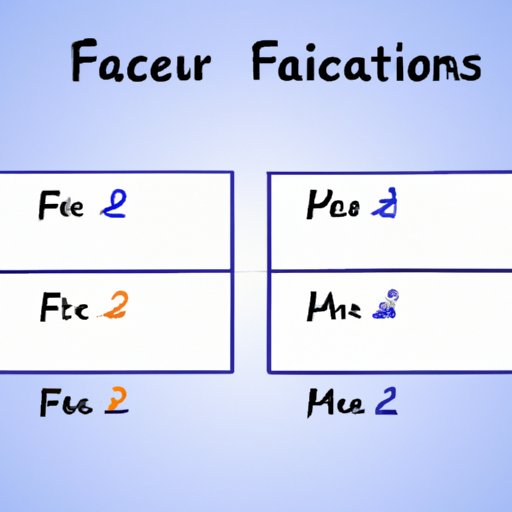Introduction
Fractions are an essential part of math and, undoubtedly, one of the most prevalent topics taught in elementary and middle school. Simplifying fractions is an important skill that is often used in everyday life. Whether you need to determine how much flour to use in a recipe or calculate a specific amount of a medication, knowing how to simplify fractions is critical. However, simplifying fractions can be difficult for many people. This article will take you through the steps of simplifying fractions and provide helpful tips to make the process more manageable.
Begin with the Basics of Fraction Simplification
A fraction is a numerical value that represents a part of a whole. It is written as a numerator over a denominator. The numerator represents the number of parts, while the denominator represents the total number of parts. To simplify a fraction, you need to reduce it to its smallest form.
Reducing or simplifying fractions involves finding the greatest common factor (GCF) of the numerator and denominator and dividing both by it. If the numerator and denominator have no common factors other than one, then the fraction is already in simplest form. Consider the example of the fraction 12/18. The numerator and denominator have a common factor of 6. Dividing both by 6 results in 2/3, which is the simplest form of the fraction.
Use Visuals and Diagrams
Using visual aids, such as pie charts or bar graphs, can enhance our understanding of fraction simplification. Visual aids can provide a clear and concise representation of fractions, making the process of simplification more accessible.
Take, for instance, a pie chart divided into four equal sections. If one-quarter of the pie is shaded, the corresponding fraction is 1/4. Conversely, if the pie is divided into eight equal sections, and two sections are shaded, the corresponding fraction is 2/8. By simplifying the fraction 2/8, we can find that it is equal to 1/4, which is the same fraction illustrated by the shaded portion on the pie chart.
Talk About the Importance of Simplifying Fractions
Simplifying fractions is a vital skill and has many applications in the real world. A significant benefit of simplifying fractions is that it makes calculations involving fractions much simpler. Without simplification, calculations may become more complex and time-consuming, increasing the likelihood of errors.
Professionals, such as architects and engineers, routinely use fractions in their work. Additionally, in everyday life, fractions are prevalent in tasks such as cooking or calculating expenses. Simplifying fractions can make these tasks more manageable and reduce the likelihood of errors.
Provide Some Real-life Examples
Imagine you have a pizza that is divided into six equal slices, you eat two slices, and you need to determine what fraction of the pizza you have left. The whole pizza is represented by the fraction 6/6; the two slices you’ve eaten are represented by the fraction 2/6 or 1/3. Simplifying 2/6 to its simplest form of 1/3 allows for an easier calculation to determine how much of the pizza is left – 4/6 or 2/3.
Use Analogies to Explain
Analogies can be useful in helping people understand the concept of fraction simplification. Consider the analogy of a pizza party where everyone at the party eats an equal number of slices. Suppose you want to order pizza for a group of ten people where each person eats three slices. How many pizzas would you need to order? Instead of calculating the total number of slices every person would eat and subtracting the number of slices from the pizza you need to order, it is easier to calculate the number of pizzas required by finding the number of slices each pizza would hold. One pizza would have eight slices, meaning you would need to order two pizzas, which would provide a total of 16 slices.
Address Common Mistakes
One common mistake people make when simplifying fractions is using the wrong method to find the greatest common factor. To avoid such errors, use the prime factorization method to determine the GCF.
Another common mistake is to forget to simplify the fraction fully to its simplest form. For example, when simplifying 6/8, it is easy to divide both by 2 and end up with the fraction of 3/4. However, this fraction has more common factors that can be divided by 3/4 can simplify several more times by dividing both the numerator and denominator by 2 resulting in 3/5.
Provide Practice Problems
Now that we have covered the basics of simplifying fractions, it’s time to practice! Here are some problems to help reinforce your understanding:
- What is the simplest form of the fraction 25/35?
- If you have four slices of pizza and have eaten one, what fraction of pizza do you have left?
- Determine the simplest form of the following fraction: 4/12
Conclusion
Simplifying fractions may seem overwhelming at first, but with practice and useful tools like visuals and analogies, it can become second nature. By simplifying fractions, you can make calculations easier, avoid errors, and tackle everyday tasks with greater ease.
